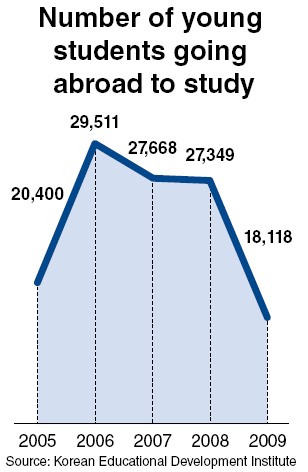“My children have no problem studying English to prepare for the college entrance exam. Among other things, there are many highly-qualified teachers and private institutes in Seoul too,” said Park, a mother of two residing in Seocho-gu, southern Seoul.
“I’m sure that the blind faith in early overseas study has become less prevalent here,” she said, adding that if her son wants to study abroad after entering a university, she is willing to support him.
The number of young students going abroad to study has continued to decrease in recent years, especially in Seoul and the metropolitan area.
According to the Korean Educational Development Institute on Wednesday, a total of 18,118 elementary, middle and high school students left the country to study abroad in 2009.

The figure is a 33.7 percent decrease from 27,349 the previous year and the largest decline in recent years, the institute said.
The number of underage students going abroad started to surge from 2000, largely driven by the overseas study boom in well-off southern Seoul.
However, having peaked in 2006 at 29,511, the number has declined for three consecutive years.
The decreasing trend has been noticed in major cities across the nation. While Incheon and Busan saw the largest decline of 40 percent and 33 percent, respectively, the Seoul figure declined 31.5 percent in 2009 compared to 2008.
When considering the proportion of students going abroad per total students, the decrease was more apparent in the metropolitan area, with the figure in Seoul and Gyeonggi Province more than doubling the national average.
Opinions are mixed, however, over the fundamental reason for the drop.
Some critics say the demand for overseas study is declining, while others say it is just a temporary phenomenon driven by a falling birthrate and economic slowdown.
According to the institute, the United States was the most favored destination for overseas study with 31.9 percent, followed by Southeast Asia with 21.9 percent, Canada with 14.6 percent and China with 8.1 percent.
By Lee Ji-yoon (jylee@heraldcorp.com)
<한글뉴스>
조기유학생 사상 최대 감소…전년比 9천명↓
3년 연속 줄어…2005년 이전 수준 환원
수요 사라졌는지, 일시적 현상인지 의견 분분
(서울=연합뉴스) 이준삼 기자 = 2009학년도에 해외로 떠난 초·중·고등학생 조 기 유학생 수가 전년 대비 1만명 가까이 급감한 것으로 나타났다.
특히 조기 유학생 감소 현상은 서울, 경기 등 수도권에서 두드러졌다.
9일 한국교육개발원이 발간한 `2010년 교육통계 분석자료집'에 따르면 2009학년 도(2009년 3월~2010년 2월) 조기 유학생 수는 총 1만8천118명으로 집계됐다.
이는 전년도인 2008학년도의 2만7천349명보다 9천231명(33.7%)이나 줄어든 것으 로 사상 최대 폭의 감소다.
조기 유학생 수는 2000년대 들어 해마다 급증해 2005학년도 2만400명, 2006학년 도 2만9천511명으로 정점을 찍고 나서 2007학년도 2만7천668명 등으로 감소 추세를 보여왔다. 2009학년도까지 3년 연속 줄어든 것이다.
학교급별로 보면 초등학생의 감소 폭이 4천162명으로 가장 컸고, 중학생 3천165 명, 고등학생 1천904명이었다.
조기 유학생의 급감 현상은 각 시도에서 공통적으로 발견됐다.
서울은 2008년 9천462명에서 6천478명으로 31.5%, 경기는 9천753명에서 5천953 명으로 38.9% 각각 감소했다.
인천은 1천413명에서 854명(-40%), 부산은 1천241명에서 835명(-33%), 대구 8 15명에서 589명(-28%), 대전 803명에서 635명(-21%)으로 각각 줄었다.
학생 1만명당 조기 유학생 수로 따져보면 서울, 경기에서 감소 폭이 유난히 두 드러졌다.
1만명당 감소 폭은 초등학생 10명(34.1명→24.1명), 중학생 15.1명(43.6명→28.
5명), 고등학생 10.6명(31.1명→20.5명)인데 서울은 각각 18.7명, 26.9명, 16.6명, 경기도는 17.6명, 26.3명, 18.6명으로 나타났다.
이는 서울, 경기 등 수도권 지역의 조기 유학생이 다른 시도에 비해 월등히 많 기 때문으로 보인다.
국가별 조기 유학생 비율은 미국 31.9%, 동남아 21.9%, 캐나다 14.6%, 중국 8.1 % 순이었다.
일부 전문가는 최근의 조기 유학생 급감 현상이 유학 수요 자체가 사라진 데서 나타난 현상이라고 분석하기도 하지만 경기침체에 따른 일시적 현상일 뿐이라는 의 견도 적잖다.
조기 유학생은 고등학교를 졸업하지 않은 초·중·고 학생들의 유학을 말하는 것으로 초·중학생의 경우 인정유학과 미인정유학, 고등학생은 자비유학 등으로 구 분된다.



















![[Today’s K-pop] BTS pop-up event to come to Seoul](http://res.heraldm.com/phpwas/restmb_idxmake.php?idx=642&simg=/content/image/2024/04/17/20240417050734_0.jpg&u=)